I thought it would be instructive to look at some of my favorite 2010 images, with a story and critique about the shot. I worked the birds by kayak pretty well early in the year, and then got in some hikes and backpacks to scenic places in the summer and fall. Although I also did some serious sea kayak trips, I couldn’t find a sea kayak favorite, perhaps because many were so commercial. In any case, no kayak shots made this short list.
Getting a favorite shot involves being where the action is when it happens, seeing—sometimes anticipating—the shot, using the right gear and technique, and often getting lucky with the light. Take your ideas into the field, but be open to alternatives. Above all, keep that viewfinder glued to your eyeball and look, look, look . . .
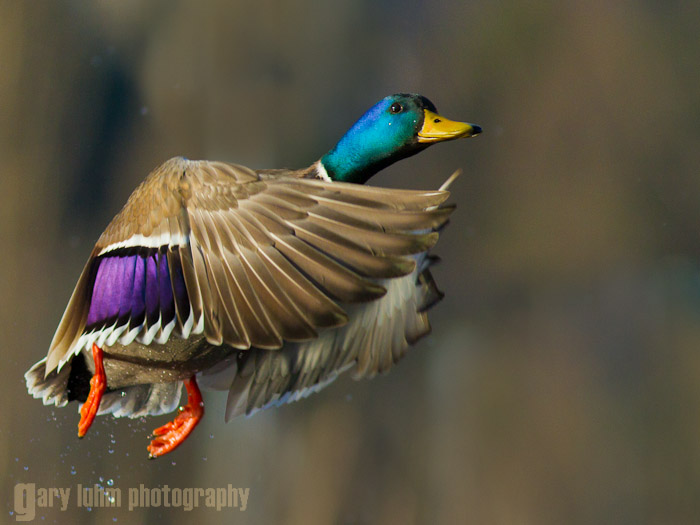
Mallard Duck at Lift Off: The male Mallard may be abundant, but it’s a handsome bird, a big duck with explosive power when it lifts off the water. I had a goal this year to capture this lift off, and I worked the area of Union Bay on Lake Washington (Seattle) by kayak numerous times to make it happen. The Mallards here are mostly tame, more likely to swim toward you looking for a handout than fly. There are a few Mallards, however, that are flighty; a few that might fly as I paddled the water trails. For the shot I envisioned, I needed a stiff breeze, and an approach from upwind so they’d face me if they flew. Here an east wind in the morning is ideal. I got a few chances last winter, usually at the onset of a high pressure cell moving in. I chose a 300mm f/4 for this work, since the Mallard is a big, approachable bird, and tracking is easier with the lighter lens. This photo was taken in the afternoon, with an east wind but a southwest sun, hence the side-lighting. I missed the initial explosion, but the head angle, wing shape, and warm light on iridescent feathers makes for a nice shot.
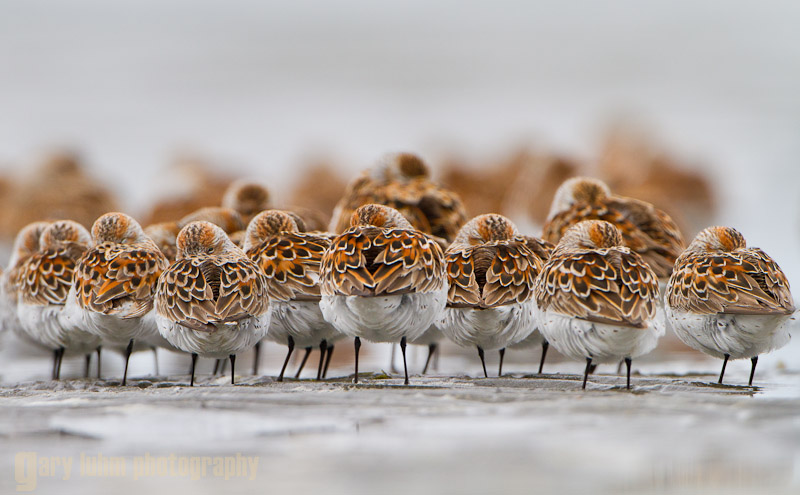
Sandpipes at Bottle Beach: During spring migration, many shorebirds use Grays Harbor on the Washington coast as a stopover. One of the best places to photograph them is Bottle Beach. Behaviorally, the migrating birds feed feverously at low tide; at high tide they flock together and rest. It may be hours before they spring into action again with the outgoing tide. Feed and rest; put on the fat.
To photograph the resting flock, I wore a wetsuit to keep warm, and did a slow “mud crawl” (I think of it more like “inch worm”) to keep them from running (or flying) away. I chose the Canon 7D (1.6x multiplier) for this, a 500mm f/4 lens (and often a 1.4x tele-converter), all to keep a working distance that doesn’t disturb the birds, yet gets me close enough to see detail. I mount the 500’s lens collar on a 4” block a wood that keeps the lens out of the sand and mud, and yields a nice low perspective. It’s my version of a ground pod. After I crawled within range, I scanned the flock and found this endearing row of Western Sandpipers. Behind the Westerns are bigger, out-of-focus Dunlin, and behind them an assemblage of Dowitchers. I particularly like the way the overcast light reveals a wonderful feather detail, especially in the flanks and belly. After I finished photographing (about 20 minutes according to my first and last photos), I “inch-wormed” away, allowing the flock its much-needed rest.
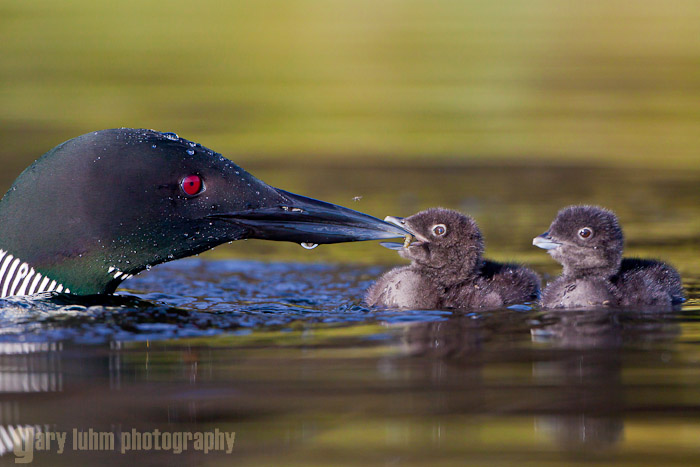
Common Loon and chicks: This photo is in some ways lucky, because I didn’t expect to find loon chicks at British Columbia’s Lac Le Jeune in mid-June. We had booked early at the Lac Le Jeune Resort because a later weekend—the one we wanted—was full, filled with guest photographers at the most-likely-loon-chick-primetime. Still, I knew the birding would be fun, and it would be my wife’s first trip. Lac Le Jeune is five hours from Seattle. We drove up with kayaks for a long weekend and some luxury “birding by kayak”. It was an unexpected thrill when resort owner Derick MacDonald informed us that two chicks from the local loon nest had just hatched.
The next morning, before breakfast, before coffee even, I was out on the lake, sun over the shoulder, to capture this image. Loon chicks leave the nest right after hatching, and swim close alongside or ride on the parents back from the start. Knowing from prior years that these loons tolerate a fairly close approach, I chose the Canon 5D II instead of my 7D, for maximum resolution, along with the 500mm f/4 to retain a decent working distance and the trademark super-tele blurred background. I love shooting from a kayak for its low angle, and I rest the lens on the foredeck to get as low as I can. I was fortunate that the loon parent repeatedly dove and returned with small aquatic insects, giving me repeated chances for stellar images of the magical scene.
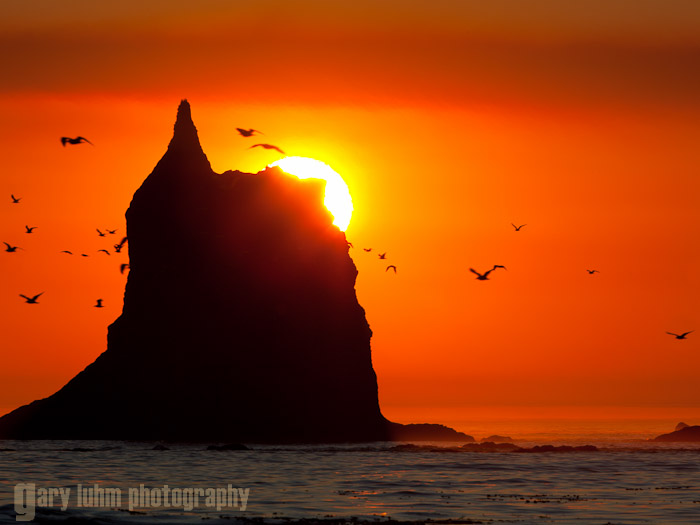
Toleak Point Gulls at Sunset: I was out at Toleak Point in Olympic National Park on a three-day coastal sea kayak trip in August. I brought my 500mm f/4 lens and tripod, which I used to frame this offshore sea stack in the setting sun. The sea stack is striking, but it’s infrequently photographed because it requires both a long lens and an arduous hike in. The coastal trail to get here is nine miles of mostly sand beach, plus several difficult sand ladders around headlands. To arrive here kayaking is also about nine miles, starting from La Push, but it’s an open ocean, advance-paddlers-only, seascape. For this image, the 500mm lens narrowed the field-of-view to just the appealing red part of the sky. The Gulls, mostly Glaucous-winged juveniles or non-breeders, were a bonus as they lifted briefly from the beach, taking off due to some late-arriving backpackers. I love the big sun and the red sky, but without the gulls it would be just another stock photo.
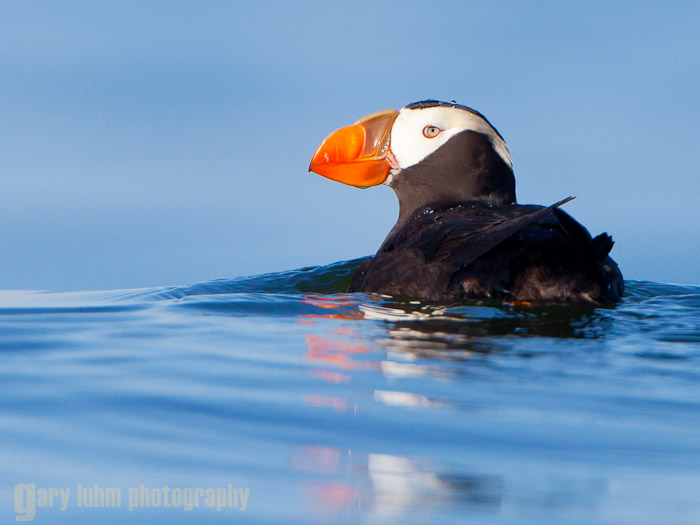
Tufted Puffin in Ocean Swell: On the same Toleak trip, in the morning I paddled out from the Point to a nearby sea stack and found Tufted Puffins flying in and out overhead. Puffins nest on a few of the sea stacks and offshore islands on the Washington coast. They’re quite particular about their choice for a home: they need a high launch platform, and they need sod for tunneling out a nest. Tufted Puffins dig a burrow several feet into a hillside. Then—since they’re shaped like a football—on take-off they drop 50 or more feet before gaining enough speed to level off, let alone climb. So photographing them at the nest—even with a 500mm lens—is dot-wildlife-photography when on the water. For flight photography, a Puffin flies fast and straight and turns in huge arcs. Though that adds some predictability, it’s also tough shot from a kayak.
I decided my best bet for a photo was to capture them floating on the water. After paddling perhaps a ½ mile out to sea, I began seeing an occasional Puffin on the surface, catching a breath between dives. Of course, this is the Pacific Ocean. Ocean swell and photography with a long lens aren’t exactly a match. It’s not possible to rest the long lens on a deck bag, like it is on a calm lake or a protected bay. I handheld the camera with my elbows jammed into my PFD, and I used my torso as a shock absorber. The image-stabilized lens helped tremendously. A windless sea was also key, reducing salt-water splash and making the rolling swell manageable. Everything came together on this morning. A Puffin surfaced, nearby and front lit, and I got the shot.
More 2010 Favorite Images Critique . . .
Gary